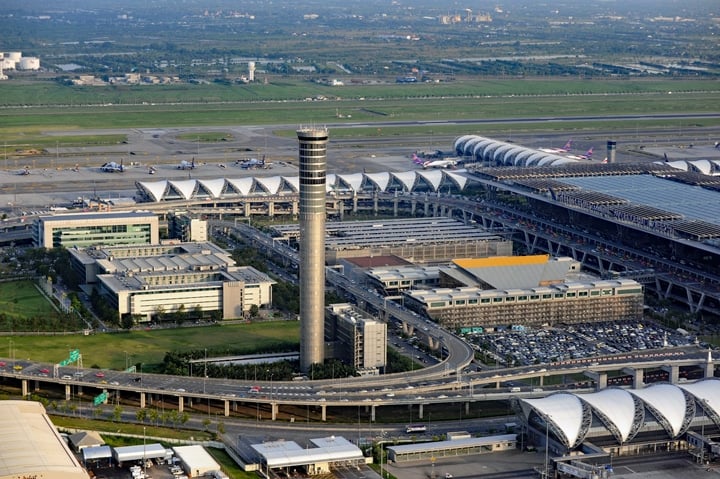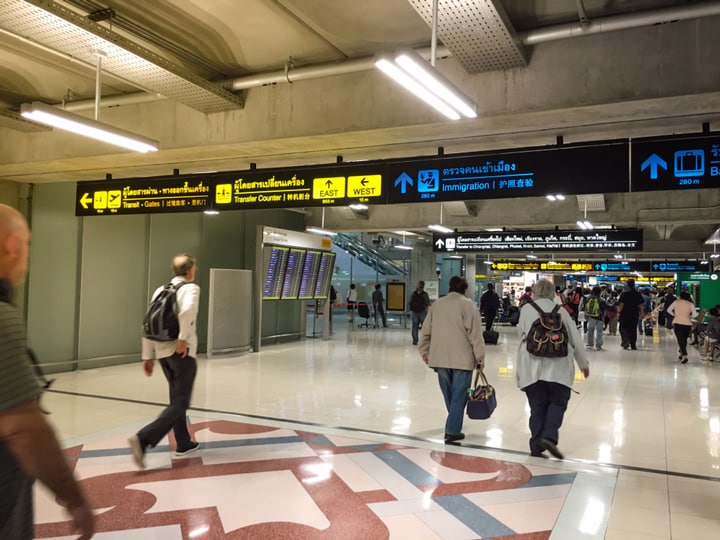
(Editorial credit: Sorbis / Shutterstock.com)
Suvarnabhumi Airport is the main international airport of Bangkok, Thailand, opened in 2006. It is one of the largest airports in Southeast Asia and serves as a major hub for air traffic in the region.
The name means 'Golden Land' in Sanskrit. The airport is known for its modern architecture, including one of the tallest air control towers in the world. It is equipped with advanced facilities to efficiently handle the large flow of passengers and flights.
Transfer
A airport transfer in the context of a transfer, is the process by which a passenger moves from one aircraft to another to continue their journey, usually on a different flight. This often happens at an intermediate airport and is a routine part of many international trips where direct flights are not available or practical. Passengers may sometimes need to go through security or customs, depending on the specific requirements of the connecting airport or country.
Travelers who travel via Bangkok Suvarnabhumi Airport (BKK) flights will often find that they have to make a transfer. This can seem like a complicated process, especially for those unfamiliar with the airport or its connecting flight system. But don't worry – with the right preparation and these tips, your transfer will be a breeze.
Preparing for your trip
Before you leave, it's important to know how much time you have between your flights. Ideally, you will want to have at least two hours between connecting flights to allow for a comfortable transfer, including any delays, going through security and immigration.

(Editorial credit: Suparin / Shutterstock.com)
Arrival at Suvarnabhumi airport
When you arrive at Suvarnabhumi Airport, follow the signs for 'Transfer' to catch your next flight. This is when you need to know whether you are making domestic or international transfers:
International transfers
For international transfers you go through transfer security. Make sure you have your boarding pass at hand and follow the signs to the international transfer desk if you do not yet have the next boarding pass.
Domestic transfers
If your domestic flight departs from Suvarnabhumi, you will need to go through immigration. Make sure you have the right documents on hand to speed up the process.
Transfer desks
Bangkok Suvarnabhumi Airport has several transfer desks located just after the security checkpoint. Here you can get help finding your next gate or if you have any problems with your connecting flight.
Facilities and services
If you have a long layover, Suvarnabhumi Airport offers several services to make your wait more pleasant:
- lounges: Several airlines have lounges where you can relax, work or have a bite to eat.
- Shops and Restaurants: There are plenty of shops and restaurants where you can shop or taste Thai cuisine.
- Free WIFI: Take advantage of free internet access to check your next flight or keep in touch with friends and family.
- Transit Hotel: For a longer stop, consider booking a room in the transit hotel within the airport.
Tips for a smooth transfer
- Stay up to date with your flight details: Check the gate and time of your next flight in advance.
- Signage: Follow signs carefully to avoid delays or confusion.
- Safety procedures: Make sure you are not carrying any prohibited items and that your liquids are properly packaged.
- Time management: Stay aware of the time, especially if you still have to go through security and/or immigration.
Closing comments
Although it can be overwhelming to transfer at a major airport like Bangkok Suvarnabhumi, it is doable with a little preparation and knowledge of the process. By following the steps above, you can ensure that your transfer goes as smoothly as possible and that you have an enjoyable travel experience. Bon voyage!


I think important information is missing here, namely the difference between international+domestic under a single booking, and two separate tickets for domestic and international.
International+domestic under single booking (combined ticket):
After arrival in BKK, one does not go through arrival immigration, but through transfer immigration (at the end of the D corridor towards A and B gates), receives a CIQ sticker and then collects the luggage from the “international” belt at the local end. destination.
Before departure from Bangkok, you go through immigration at the departure point, receive a CIQ sticker and then go through transfer security in BKK (available at both end points of the D pier) to the international part of the airport to the gate for the onward flight.
The minimum connection time can be less than 2 hours and is determined by the airline. If you miss the flight due to a delay in the first flight, the airline will automatically rebook at no cost.
Separate tickets for domestic and international:
After arriving in BKK, you go through immigration, collect your luggage and then check in yourself for the onward flight.
When departing from a local airport, you fly to BKK, collect your luggage, then check in for the international flight and then go through immigration in BKK.
2 hours is usually sufficient for this. However, if the first flight is delayed, you are responsible for rebooking the second flight if missed. At their own expense.
Both methods have advantages and disadvantages. The first is usually the most expensive, but not always. Moreover, the first method cannot be booked with all airlines.
Dear Editor,
With such a perfect explanation, most travelers can't go wrong!
A very clear explanation but it is not correct.
For a connecting domestic flight, you do not always have to go through customs control. If you continue flying with the same airline, your suitcase will immediately be tagged and you can go from the arrival gate directly to the new gate for your connecting flight after inspection.
Hugo
Willem, thanks for the detailed description, which I think is very accurate. I have just returned for 4 weeks and have gone through the entire cycle, including a new boarding pass. EVA Air had a 1,5 hour delay on departure, which was my transfer time. In BKK I was already met by a hostess who directed me to the Bankok Airways desk where I received a new boarding pass for Chiang Mai. Through customs stamps + inspection and you're done. Then wait 2 hours and continue to Chiang Mai. In Chiang Mai my luggage was already waiting for the belt. All in all, a relaxing flight there and back, but I found that it was best to check in at the desk and not at the self-service counter. Let's see what the weather is like next year